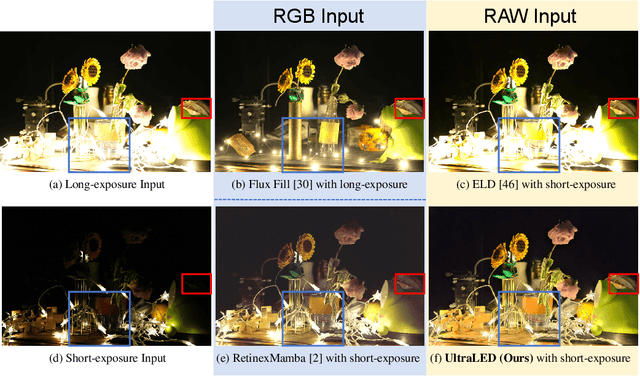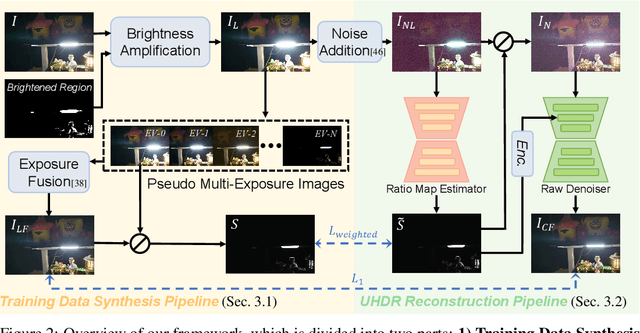Image Denoising
Image denoising is the process of removing noise from images to improve their quality.
Papers and Code
Noise Projection: Closing the Prompt-Agnostic Gap Behind Text-to-Image Misalignment in Diffusion Models
Oct 16, 2025In text-to-image generation, different initial noises induce distinct denoising paths with a pretrained Stable Diffusion (SD) model. While this pattern could output diverse images, some of them may fail to align well with the prompt. Existing methods alleviate this issue either by altering the denoising dynamics or by drawing multiple noises and conducting post-selection. In this paper, we attribute the misalignment to a training-inference mismatch: during training, prompt-conditioned noises lie in a prompt-specific subset of the latent space, whereas at inference the noise is drawn from a prompt-agnostic Gaussian prior. To close this gap, we propose a noise projector that applies text-conditioned refinement to the initial noise before denoising. Conditioned on the prompt embedding, it maps the noise to a prompt-aware counterpart that better matches the distribution observed during SD training, without modifying the SD model. Our framework consists of these steps: we first sample some noises and obtain token-level feedback for their corresponding images from a vision-language model (VLM), then distill these signals into a reward model, and finally optimize the noise projector via a quasi-direct preference optimization. Our design has two benefits: (i) it requires no reference images or handcrafted priors, and (ii) it incurs small inference cost, replacing multi-sample selection with a single forward pass. Extensive experiments further show that our prompt-aware noise projection improves text-image alignment across diverse prompts.
Zero-Shot CFC: Fast Real-World Image Denoising based on Cross-Frequency Consistency
Oct 14, 2025Zero-shot denoisers address the dataset dependency of deep-learning-based denoisers, enabling the denoising of unseen single images. Nonetheless, existing zero-shot methods suffer from long training times and rely on the assumption of noise independence and a zero-mean property, limiting their effectiveness in real-world denoising scenarios where noise characteristics are more complicated. This paper proposes an efficient and effective method for real-world denoising, the Zero-Shot denoiser based on Cross-Frequency Consistency (ZSCFC), which enables training and denoising with a single noisy image and does not rely on assumptions about noise distribution. Specifically, image textures exhibit position similarity and content consistency across different frequency bands, while noise does not. Based on this property, we developed cross-frequency consistency loss and an ultralight network to realize image denoising. Experiments on various real-world image datasets demonstrate that our ZSCFC outperforms other state-of-the-art zero-shot methods in terms of computational efficiency and denoising performance.
Pruning Overparameterized Multi-Task Networks for Degraded Web Image Restoration
Oct 16, 2025Image quality is a critical factor in delivering visually appealing content on web platforms. However, images often suffer from degradation due to lossy operations applied by online social networks (OSNs), negatively affecting user experience. Image restoration is the process of recovering a clean high-quality image from a given degraded input. Recently, multi-task (all-in-one) image restoration models have gained significant attention, due to their ability to simultaneously handle different types of image degradations. However, these models often come with an excessively high number of trainable parameters, making them computationally inefficient. In this paper, we propose a strategy for compressing multi-task image restoration models. We aim to discover highly sparse subnetworks within overparameterized deep models that can match or even surpass the performance of their dense counterparts. The proposed model, namely MIR-L, utilizes an iterative pruning strategy that removes low-magnitude weights across multiple rounds, while resetting the remaining weights to their original initialization. This iterative process is important for the multi-task image restoration model's optimization, effectively uncovering "winning tickets" that maintain or exceed state-of-the-art performance at high sparsity levels. Experimental evaluation on benchmark datasets for the deraining, dehazing, and denoising tasks shows that MIR-L retains only 10% of the trainable parameters while maintaining high image restoration performance. Our code, datasets and pre-trained models are made publicly available at https://github.com/Thomkat/MIR-L.
Unsupervised Deep Generative Models for Anomaly Detection in Neuroimaging: A Systematic Scoping Review
Oct 16, 2025Unsupervised deep generative models are emerging as a promising alternative to supervised methods for detecting and segmenting anomalies in brain imaging. Unlike fully supervised approaches, which require large voxel-level annotated datasets and are limited to well-characterised pathologies, these models can be trained exclusively on healthy data and identify anomalies as deviations from learned normative brain structures. This PRISMA-guided scoping review synthesises recent work on unsupervised deep generative models for anomaly detection in neuroimaging, including autoencoders, variational autoencoders, generative adversarial networks, and denoising diffusion models. A total of 49 studies published between 2018 - 2025 were identified, covering applications to brain MRI and, less frequently, CT across diverse pathologies such as tumours, stroke, multiple sclerosis, and small vessel disease. Reported performance metrics are compared alongside architectural design choices. Across the included studies, generative models achieved encouraging performance for large focal lesions and demonstrated progress in addressing more subtle abnormalities. A key strength of generative models is their ability to produce interpretable pseudo-healthy (also referred to as counterfactual) reconstructions, which is particularly valuable when annotated data are scarce, as in rare or heterogeneous diseases. Looking ahead, these models offer a compelling direction for anomaly detection, enabling semi-supervised learning, supporting the discovery of novel imaging biomarkers, and facilitating within- and cross-disease deviation mapping in unified end-to-end frameworks. To realise clinical impact, future work should prioritise anatomy-aware modelling, development of foundation models, task-appropriate evaluation metrics, and rigorous clinical validation.
From Language to Locomotion: Retargeting-free Humanoid Control via Motion Latent Guidance
Oct 16, 2025Natural language offers a natural interface for humanoid robots, but existing language-guided humanoid locomotion pipelines remain cumbersome and unreliable. They typically decode human motion, retarget it to robot morphology, and then track it with a physics-based controller. However, this multi-stage process is prone to cumulative errors, introduces high latency, and yields weak coupling between semantics and control. These limitations call for a more direct pathway from language to action, one that eliminates fragile intermediate stages. Therefore, we present RoboGhost, a retargeting-free framework that directly conditions humanoid policies on language-grounded motion latents. By bypassing explicit motion decoding and retargeting, RoboGhost enables a diffusion-based policy to denoise executable actions directly from noise, preserving semantic intent and supporting fast, reactive control. A hybrid causal transformer-diffusion motion generator further ensures long-horizon consistency while maintaining stability and diversity, yielding rich latent representations for precise humanoid behavior. Extensive experiments demonstrate that RoboGhost substantially reduces deployment latency, improves success rates and tracking accuracy, and produces smooth, semantically aligned locomotion on real humanoids. Beyond text, the framework naturally extends to other modalities such as images, audio, and music, providing a general foundation for vision-language-action humanoid systems.
pi-Flow: Policy-Based Few-Step Generation via Imitation Distillation
Oct 16, 2025Few-step diffusion or flow-based generative models typically distill a velocity-predicting teacher into a student that predicts a shortcut towards denoised data. This format mismatch has led to complex distillation procedures that often suffer from a quality-diversity trade-off. To address this, we propose policy-based flow models ($\pi$-Flow). $\pi$-Flow modifies the output layer of a student flow model to predict a network-free policy at one timestep. The policy then produces dynamic flow velocities at future substeps with negligible overhead, enabling fast and accurate ODE integration on these substeps without extra network evaluations. To match the policy's ODE trajectory to the teacher's, we introduce a novel imitation distillation approach, which matches the policy's velocity to the teacher's along the policy's trajectory using a standard $\ell_2$ flow matching loss. By simply mimicking the teacher's behavior, $\pi$-Flow enables stable and scalable training and avoids the quality-diversity trade-off. On ImageNet 256$^2$, it attains a 1-NFE FID of 2.85, outperforming MeanFlow of the same DiT architecture. On FLUX.1-12B and Qwen-Image-20B at 4 NFEs, $\pi$-Flow achieves substantially better diversity than state-of-the-art few-step methods, while maintaining teacher-level quality.
UltraLED: Learning to See Everything in Ultra-High Dynamic Range Scenes
Oct 09, 2025



Ultra-high dynamic range (UHDR) scenes exhibit significant exposure disparities between bright and dark regions. Such conditions are commonly encountered in nighttime scenes with light sources. Even with standard exposure settings, a bimodal intensity distribution with boundary peaks often emerges, making it difficult to preserve both highlight and shadow details simultaneously. RGB-based bracketing methods can capture details at both ends using short-long exposure pairs, but are susceptible to misalignment and ghosting artifacts. We found that a short-exposure image already retains sufficient highlight detail. The main challenge of UHDR reconstruction lies in denoising and recovering information in dark regions. In comparison to the RGB images, RAW images, thanks to their higher bit depth and more predictable noise characteristics, offer greater potential for addressing this challenge. This raises a key question: can we learn to see everything in UHDR scenes using only a single short-exposure RAW image? In this study, we rely solely on a single short-exposure frame, which inherently avoids ghosting and motion blur, making it particularly robust in dynamic scenes. To achieve that, we introduce UltraLED, a two-stage framework that performs exposure correction via a ratio map to balance dynamic range, followed by a brightness-aware RAW denoiser to enhance detail recovery in dark regions. To support this setting, we design a 9-stop bracketing pipeline to synthesize realistic UHDR images and contribute a corresponding dataset based on diverse scenes, using only the shortest exposure as input for reconstruction. Extensive experiments show that UltraLED significantly outperforms existing single-frame approaches. Our code and dataset are made publicly available at https://srameo.github.io/projects/ultraled.
Adaptive double-phase Rudin--Osher--Fatemi denoising model
Oct 05, 2025We propose a new image denoising model based on a variable-growth total variation regularization of double-phase type with adaptive weight. It is designed to reduce staircasing with respect to the classical Rudin--Osher--Fatemi model, while preserving the edges of the image in a similar fashion. We implement the model and test its performance on synthetic and natural images in 1D and 2D over a range of noise levels.
Moments Matter: Posterior Recovery in Poisson Denoising via Log-Networks
Oct 08, 2025


Poisson denoising plays a central role in photon-limited imaging applications such as microscopy, astronomy, and medical imaging. It is common to train deep learning models for denoising using the mean-squared error (MSE) loss, which corresponds to computing the posterior mean $\mathbb{E}[x \mid y]$. When the noise is Gaussian, Tweedie's formula enables approximation of the posterior distribution through its higher-order moments. However, this connection no longer holds for Poisson denoising: while $ \mathbb{E}[x \mid y] $ still minimizes MSE, it fails to capture posterior uncertainty. We propose a new strategy for Poisson denoising based on training a log-network. Instead of predicting the posterior mean $ \mathbb{E}[x \mid y] $, the log-network is trained to learn $\mathbb{E}[\log x \mid y]$, leveraging the logarithm as a convenient parameterization for the Poisson distribution. We provide a theoretical proof that the proposed log-network enables recovery of higher-order posterior moments and thus supports posterior approximation. Experiments on simulated data show that our method matches the denoising performance of standard MMSE models while providing access to the posterior.
Asynchronous Denoising Diffusion Models for Aligning Text-to-Image Generation
Oct 06, 2025Diffusion models have achieved impressive results in generating high-quality images. Yet, they often struggle to faithfully align the generated images with the input prompts. This limitation arises from synchronous denoising, where all pixels simultaneously evolve from random noise to clear images. As a result, during generation, the prompt-related regions can only reference the unrelated regions at the same noise level, failing to obtain clear context and ultimately impairing text-to-image alignment. To address this issue, we propose asynchronous diffusion models -- a novel framework that allocates distinct timesteps to different pixels and reformulates the pixel-wise denoising process. By dynamically modulating the timestep schedules of individual pixels, prompt-related regions are denoised more gradually than unrelated regions, thereby allowing them to leverage clearer inter-pixel context. Consequently, these prompt-related regions achieve better alignment in the final images. Extensive experiments demonstrate that our asynchronous diffusion models can significantly improve text-to-image alignment across diverse prompts. The code repository for this work is available at https://github.com/hu-zijing/AsynDM.
 Add to Chrome
Add to Chrome Add to Firefox
Add to Firefox Add to Edge
Add to Edge